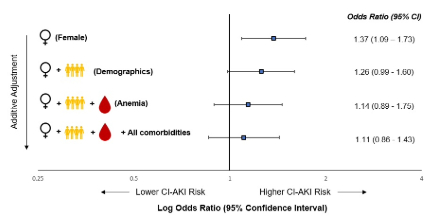Final ID: Sa3176
Sex Differences in Rates of Contrast-Induced Acute Kidney Injury After Percutaneous Coronary Intervention
Abstract Body (Do not enter title and authors here): Background: Previous studies have shown conflicting results regarding higher rates of contrast-induced acute kidney injury (CI-AKI) after percutaneous coronary intervention (PCI) among women as compared to men. We sought to identify covariates that explain possible sex differences in rates of CI-AKI after PCI.
Methods: This was a retrospective observational cross-sectional study of all PCIs performed at Cedars-Sinai Medical Center from 2020-2023, sourced from the National Cardiovascular Data Registry. The primary outcome and regressor were CI-AKI and sex, respectively. Covariates were other patient demographics, comorbidities, procedural factors, and health insurance. We excluded patients with pre-PCI dialysis requirement or without pre/post-PCI creatinine. We used multivariable-adjusted logistic regression to evaluate rates of CI-AKI among women versus men. Using additive adjustment, we identified factors that accounted for the sex differences.
Results: Of 2971 PCIs included, 820 (27.6%) were performed in women, 316 (10.6%) in Black patients and 283 (9.5%) in Hispanic patients. On average, women were older than men (73.9 vs 68.6 years, p<0.001). Women had higher rates of anemia compared to men (19.8% vs 10.9%, p<0.001). In bivariate analysis, women experienced more CI-AKI than men (15.0% vs 11.4%, p=0.008) with an odds ratio (OR) of 1.37. Additive adjustment with demographics reduced the OR of CI-AKI for women to 1.26, accounting for ~30% of the identified sex difference. Additional adjustment with both demographics and anemia yielded an OR for CI-AKI of 1.14, explaining ~60% of the sex difference. Adjustment with demographics and all comorbidities accounted for ~75% of the sex difference, with an OR for CI-AKI of 1.11. Further additive adjustment for procedural factors and insurance had negligible contributions. The sex difference was no longer significant after adjustment for demographics.
Conclusion: Women undergoing PCI had higher rates of CI-AKI as compared to men, though this was no longer significant with multivariable analysis. The risk for CI-AKI for women over men was primarily contingent on demographics and comorbidities, with anemia accounting for a substantial proportion of this risk.
Methods: This was a retrospective observational cross-sectional study of all PCIs performed at Cedars-Sinai Medical Center from 2020-2023, sourced from the National Cardiovascular Data Registry. The primary outcome and regressor were CI-AKI and sex, respectively. Covariates were other patient demographics, comorbidities, procedural factors, and health insurance. We excluded patients with pre-PCI dialysis requirement or without pre/post-PCI creatinine. We used multivariable-adjusted logistic regression to evaluate rates of CI-AKI among women versus men. Using additive adjustment, we identified factors that accounted for the sex differences.
Results: Of 2971 PCIs included, 820 (27.6%) were performed in women, 316 (10.6%) in Black patients and 283 (9.5%) in Hispanic patients. On average, women were older than men (73.9 vs 68.6 years, p<0.001). Women had higher rates of anemia compared to men (19.8% vs 10.9%, p<0.001). In bivariate analysis, women experienced more CI-AKI than men (15.0% vs 11.4%, p=0.008) with an odds ratio (OR) of 1.37. Additive adjustment with demographics reduced the OR of CI-AKI for women to 1.26, accounting for ~30% of the identified sex difference. Additional adjustment with both demographics and anemia yielded an OR for CI-AKI of 1.14, explaining ~60% of the sex difference. Adjustment with demographics and all comorbidities accounted for ~75% of the sex difference, with an OR for CI-AKI of 1.11. Further additive adjustment for procedural factors and insurance had negligible contributions. The sex difference was no longer significant after adjustment for demographics.
Conclusion: Women undergoing PCI had higher rates of CI-AKI as compared to men, though this was no longer significant with multivariable analysis. The risk for CI-AKI for women over men was primarily contingent on demographics and comorbidities, with anemia accounting for a substantial proportion of this risk.
More abstracts on this topic:
Area Deprivation, Social Vulnerability, and Incident Hypertension in Men and Women at Midlife: The Coronary Artery Risk Development in Young Adults (CARDIA) Study
Gaffey Allison, Burg Matthew, Lewis Cora, Gunderson Erica, Yano Yuichiro, Knutson Kristen, Haskell Sally, Schwartz Joseph
A novel Urocortin-2 analog COR-1167 corrects cardiac and renal dysfunction on top of Empagliflozin in a rat model of acute decompensated heart failureStephan Yohan, Corruble Clement, Charrier Lucie, Nicol Lionel, Kowala Mark, Ozoux Marie-laure, Lawson Francesca, Janiak Philip, Mulder Paul

